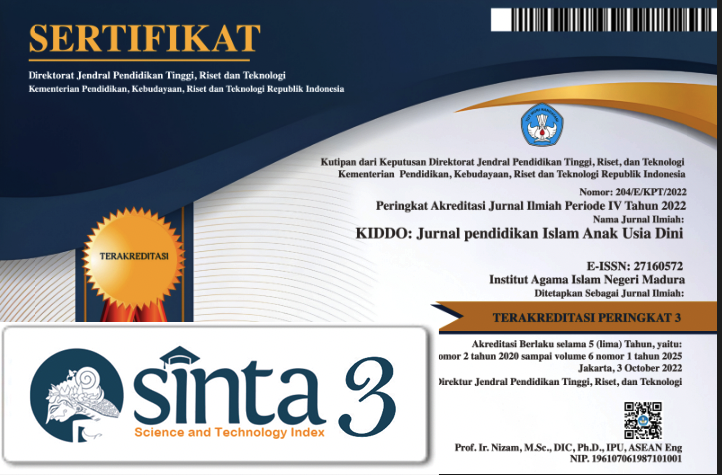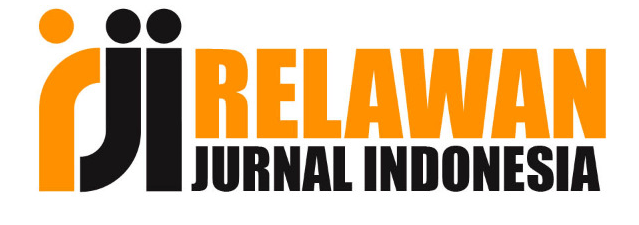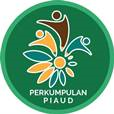Penerapan Metode Tilawati dalam Pembelajaran Membaca Al-Qur'an pada Anak Usia Dini di RA Darul Ulum Mani'an Majungan Pademawu Pamekasan
 Abstract views: 1290
,
Abstract views: 1290
,
 PDF downloads: 729
PDF downloads: 729
Abstract
This study aims to determine the implementation of the Tilawati Method in learning to read al-Qur’an in early childhood and the advantages and disadvantages of inhibiting and supporting factors in the RA Darul Ulum Mani’an Majungan Pademawu Pamekasan.
This research uses a descriptive qualitative approach in the form of written words.Source of data used to obtain data through observation, interview and documentation. Interview is a question and answer session with face to face interviewed about the problem under study.Observation is a data collection technique that is done by conducting careful research and systematic recording. Documentation can be done by researchcers to obtain supporting data about the findings obtained in the field. Analysis of the data in this study researchers through several stages, namely data reduction, data presentation and drawing conclusions. While checking the data is done through an extension of participation, research perseverance and triangulation. In this study, researchers used source triangulation because there was not enough information to obtain one source.
The results of this study indicate that:first, the application of the Tilawati method in RA Darul Ulum went well even though in fact there were still inhibiting factors but it did not become a major barrier to the application of the Tilawati method. Secondly, advantages the application of the tilawati method, namely balancing the learning approach classically and individually. The drawback is that for those who do not pass smoothly it will also take a long time because this method of passing is not determined by the month or year. Third, (a) supporting factor, easy method so that it does not make the child depressed. (b) inhibiting factors, lack of facilities so that using only one approach.
Downloads
References
Ahmad, Izzan. 2012. Tafsir Pendidikan Studi Ayat-Ayat Berdimensi Pendidikan. Banten: Pustaka Aufa Media.
Bobbi De Potter dan Mike Hernarcki.2009.Quantum Learning, Membiasakan Belajar Nyaman dan Menyenangkan, terj.Alwiyah Abdurrahman. Bandung. Kaifa.
Darajat , Zakiyah,et.al. 2010. Metodik Khusus Pendidikan Agama Islam.Jakarta: Bumi Aksara.
Didin Jamaluddin.2010. Metode Pendidikan Anak. Bandung: Pustaka Al-Fikriis.
Juwariyah.2010. Dasar-Dasar Pendidikan Anak dalam Al-Qur’an. Yogyakarta: Teras.
Majid, Abdul. 2014. Strategi Pembelajaran. Bandung: PT Remaja Rosdakarya.
Mulyono Abdurrahman.1999.Pendidikan Bagi Anak yang Berkesulitan Belajar.Jakarta. Rineka Cipta.
Moleong, Lexy J. 2011. Metodologi Penelitian Kualitatif. Bandung: PT. Remaja Rosdakarya.
Mutmainnah,Siti. 2011. Penerapan metode tilawati dalam pembelajaran membaca al-qur’an di MI al-Falah Beran Ngawi, Skripsi: IAIN walisongo semarang.
Srijatun.2017.Implementasi Pembelajaran Baca Tulis Al-Qur’an Dengan Metode Iqro’ Pada Anak Usia Dini Di RA Perwanida Slawi Kabupaten Tegal, jurnal pendidikan, UIN Walisongo Semarang .
Widyanti, Eka. 2015. Penerapan metode Tilawati dalam Pembelajaran membaca al-Qur’an di TK ‘Aisyiyah Bustanul Athfal VI Purwokerto, Skripsi : IAIN Purwokerto.
-
The journal operates an Open Access policy under a Creative Commons 4.0 International license. The terms of the license are:
Share— copy and redistribute the material in any medium or format
Adapt— remix, transform, and build upon the material for any purpose, even commercially.
1. Authors retain copyright and grant the journal right of first publication with the work simultaneously licensed under a Creative Commons License.that allows others to share the work with an acknowledgement of the work’s authorship and initial publication in this journal
2. Authors are permitted and encouraged to post their work online (e.g., in institutional repositories or on their website) prior to and during the submission process, as it can lead to productive exchanges, as well as earlier and greater citation of published work (See The Effect of Open Access).
Jurnal Kiddo is licensed under a Creative Commons
n Access).














